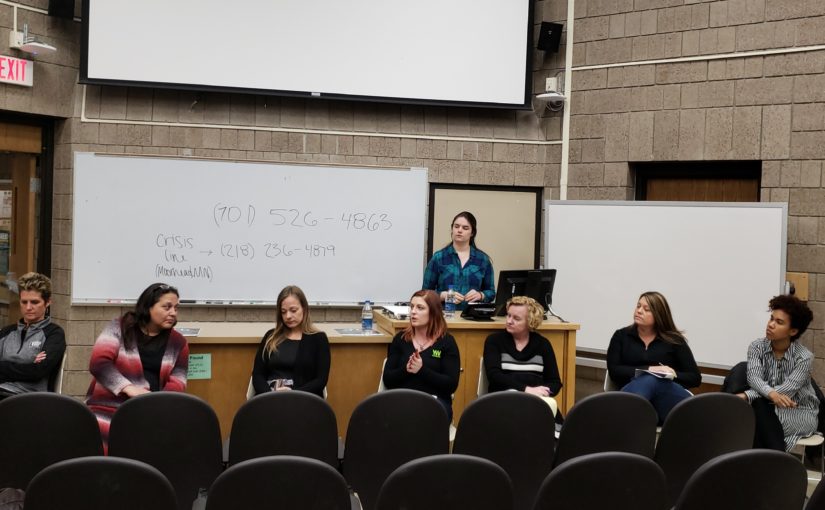Four students gathered together as an activist group, for a project in WGS 350, and brought awareness to sex trafficking issues through a panel.
On April 9, Tabitha Heinz, Tyrza Hoines, Wilijar Ojuro and Kailyn Straub, held a panel of six women who work in the Fargo-Moorhead area in hopes of helping victims of human trafficking.
The panelists explained sex trafficking as, when someone is facilitating the exchange for sex, the third party is benefiting while the person being involved is not getting anything. This can happen in relationships, families, prostitution, etc. She gave the example of a mother being unable to pay rent so she has her daughter sleep with the landlord, she is now facilitating that exchange while not being directly involved in the encounter making her the “pimp.”
Many believe the age range of victims is 19 years old, but in reality, people are normally around the ages of 13 to 14.
People don’t know how to see the signs or how to act if they are being sex trafficked or seeing someone being sex trafficked, leading to an uneducated decision. This group used this activism project to inform others and spread awareness to something that people do not realize are also in the FM area.
Panelists explained how many people aren’t aware that anyone can be involved in sex trafficking, professors, people you trust, hotels, truck stops, people in the community, etc.
One of the panelists was Jasmin Young-Bradshaw the Advocacy Supervisor at the Rape and Abuse Crisis Center, which offers emotional support, crisis intervention, education, housing, medical, etc, along with a 24-hour crisis line.
“We (Rape and Abuse Crisis Center) were already seeing victims of domestic violence and sexual assault, but without asking the right questions we didn’t know that we were also serving victims of sex trafficking as well,” Young-Bradshaw explained.
Tammi Kromenaker, Clinic Director at Red River Women’s Clinic explained that when they come in contact with someone who has been sex trafficked it is normally because they have an unwanted pregnancy.
“We’re not necessarily out here trying to catch people as much as we are — as a community trying to prevent things from happening and making sure that there’s safe places,” Jemima Heppner, advocate at Missing Persons of ND said.
Young-Bradshaw explained how sex traffickers are using this as a job 24/7 and that they are always looking for new ways of doing this, so although discouraging “this is our work, but this is their life — it’s something to be mindful about.”
When sharing the event, Hoines noticed that many people do not realize it is in our area, that it isn’t just something that happens across the world, but that anyone in the room could be a sex trafficker or a victim.
The panelists shared stories, for example one of the panelists, Lisa Hanson, Family and Women’s Ministry at Atonement Lutheran Church and who also started organization called “Voice for the Captives” where it brings people together to try and abolish sex trafficking through prayer and awareness, shared a story.
She knew a girl who was approached in the Mall of America, where she had a large pile of clothes she was planning on buying, her mother left her in the store to go to another store. While the girl was waiting in line a man approached her and offered to pay for all her clothes, luckily the mother came back and automatically the man was gone. What people don’t realize is that this is a normal occurrence in the area.
“You don’t have to go far to see it, and — we too have our own vulnerabilities about us that make us susceptible to (it),” Young-Bradshaw said.
Another story was told by MJ, who used to be an underground street chaplain. They had a case where a girl was trying to sell her prom dress, while selling it see met up in a private place and the man asked her to put it on and how he would give more for extra services. The girl recorded the conversation so it was easy to catch the man.
The main question among the group and the audience at the panel was what can we do and how can we help?
“Making sure the people you come in contact know that they’re priceless, there’s not a dollar on their head, they’re priceless — can’t be bought, not by food, not by anything else, and as a community we can provide a safe place to be,” Jemima Heppner, advocate at Missing Persons of ND, explained.
“I think a lot of times people want to get involved and help, because that’s what we do in human nature, but it could be really unsafe and dangerous for you, so I think as soon as you can call law enforcement that would be my first instinct, and it’s hard because you don’t always know if they’re going to respond or what that’s going to look like, but you just have to make sure you’re safe first,” Melissa Williams, Human Trafficking Navigator at Youth Works, said.
Three things that the panel touched on for ways to stay safe as well as help were:
Pathlight App which allows you to feel safe by putting in your location and how long it will take you to arrive if you do not turn it off the police will show up looking for you to clarify you are okay.
Crisis line in Moorhead, MN: 218-236-4879
National Human Trafficking Resource Center Hot Line: 1-888-373-7888
